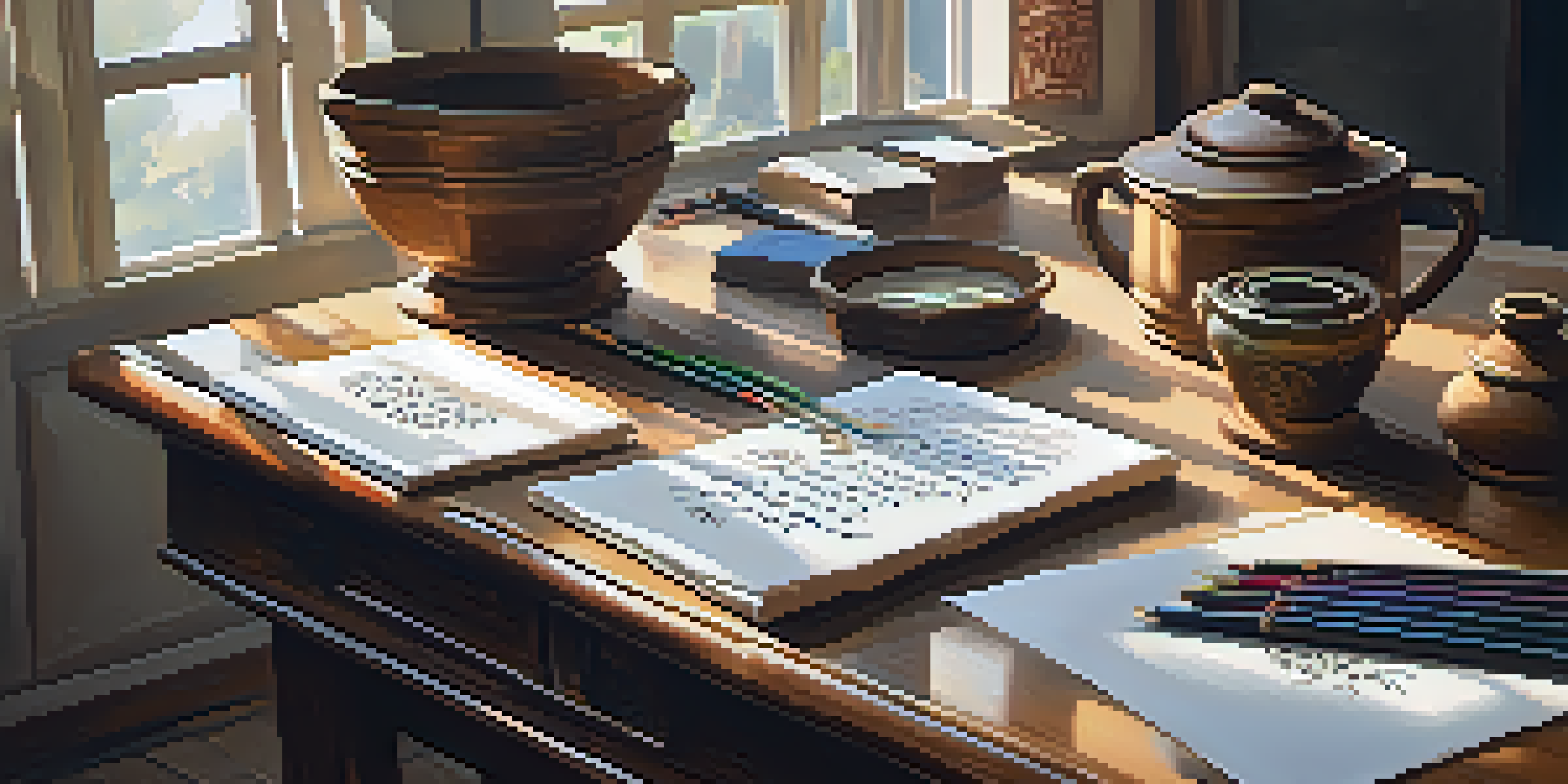The Importance of Practice in Developing Calligraphy Skills

Understanding Calligraphy and Its Artistry
Calligraphy is more than just beautiful writing; it's an art form that requires precision and creativity. At its core, calligraphy combines various styles of lettering with personal flair, making each piece unique. Whether you're writing a heartfelt note or creating an intricate design, understanding the basics is key to developing your skills.
Calligraphy is a form of art that transcends mere writing; it is a journey of self-expression and creativity.
To truly appreciate calligraphy, one must dive into its history and techniques. Different cultures have their own styles, from the elegant strokes of Western calligraphy to the flowing characters of Eastern scripts. Embracing this diversity not only enriches your practice but also inspires creativity in your work.
Ultimately, calligraphy is about expression, and practice allows you to refine that expression over time. The more you practice, the more you'll find your own voice in this beautiful discipline, leading to a rewarding journey of artistic discovery.
The Role of Consistent Practice in Skill Development
Like any skill, calligraphy flourishes with consistent practice. Regularly dedicating time to your craft helps reinforce muscle memory, making the movements of your hand more fluid and natural. Over time, you'll notice that your strokes become more confident and your letters more consistent.

Think of practice as a workout for your hand and mind. Just as athletes train to improve their performance, calligraphers hone their skills through repetition. This commitment not only enhances your technique but also builds your ability to create unique styles and designs.
Practice is Key to Mastery
Consistent practice reinforces muscle memory and enhances your calligraphic skills over time.
Additionally, setting aside time for practice encourages you to experiment and explore different styles. The more you push your boundaries, the more you'll discover what resonates with you, ultimately leading to a distinctive calligraphic voice.
Setting Realistic Goals for Your Practice Sessions
To make the most of your practice, it's essential to set realistic goals. Rather than overwhelming yourself with grand ambitions, focus on small, achievable objectives. For instance, you might aim to master a specific letter or flourish before moving on to more complex designs.
Practice is the key to unlocking your potential; every stroke is a step towards mastery.
Breaking your practice into manageable segments not only makes it less daunting but also allows you to track your progress more effectively. Celebrating small victories can boost your motivation and keep the practice enjoyable.
Remember, the journey of learning calligraphy is a marathon, not a sprint. By setting clear goals, you can build a solid foundation that encourages steady improvement and keeps your passion alive.
Incorporating Different Techniques into Your Practice
Calligraphy is a versatile art form, and incorporating various techniques can enhance your skills. From brush lettering to dip pen calligraphy, exploring different methods broadens your understanding of the craft. Each technique offers unique challenges and rewards that contribute to your overall growth.
For example, practicing with a brush pen can help you develop a sense of pressure and release that is crucial in creating beautiful strokes. Conversely, using a dip pen may teach you about ink flow and consistency, both important elements of calligraphy.
Set Achievable Goals
Establishing realistic objectives for your practice helps track progress and maintains motivation.
By diversifying your practice routine, you not only keep things interesting but also cultivate a well-rounded skill set. This exploration fosters creativity and can lead to innovative styles that reflect your individuality.
Finding Inspiration to Fuel Your Calligraphy Journey
Inspiration can be found in the most unexpected places, and as a calligrapher, it's vital to keep your creative well full. Whether it's art, nature, or even architecture, observing the world around you can ignite fresh ideas for your work. Taking time to immerse yourself in different environments can spark new concepts and styles.
Social media platforms like Instagram and Pinterest are treasure troves for calligraphy enthusiasts. Following other artists not only provides inspiration but also connects you with a community of like-minded individuals who can offer support and feedback.
Additionally, don’t shy away from participating in calligraphy workshops or local classes. Engaging with fellow artists can open doors to new techniques and styles, enriching your practice and keeping your passion alive.
Tracking Your Progress: The Importance of Reflection
As you embark on your calligraphy journey, taking the time to reflect on your progress is crucial. Keeping a journal or portfolio of your work can help you see how far you've come and identify areas for improvement. This documentation not only showcases your skills but also serves as a motivational reminder of your dedication.
Reflection allows you to recognize patterns in your practice. By analyzing what techniques work best for you and where you face challenges, you can tailor your practice sessions for maximum effectiveness. This self-awareness is key to continuous growth.
Community Enhances Learning
Joining a supportive community fosters collaboration, feedback, and inspiration in your calligraphy journey.
Moreover, celebrating your achievements, no matter how small, can boost your confidence. Acknowledging your hard work and progress encourages a positive mindset that fuels your passion for calligraphy.
Building a Supportive Community for Calligraphy Enthusiasts
Joining a community of fellow calligraphy enthusiasts can significantly enhance your learning experience. Whether online or in-person, these connections provide a platform for sharing tips, techniques, and inspiration. Being part of a community fosters a sense of belonging that can motivate you to practice more consistently.
Engaging with others can also offer valuable feedback on your work. Constructive criticism helps you grow and refine your skills, while encouragement from peers can keep your spirits high. Collaborating with other artists may even lead to exciting projects and opportunities.

Remember, everyone’s calligraphy journey is unique. Embracing a community allows you to learn from diverse experiences, enriching your own practice and making the journey all the more enjoyable.